Calibration Services
Electrical: Others
Electrical Safety Analyzer
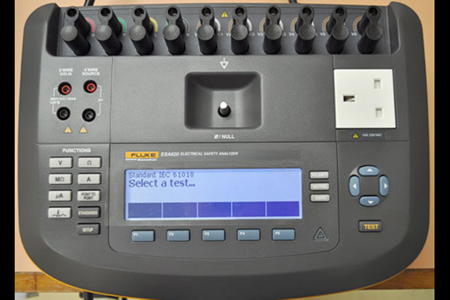 Electrical Safety Analyzer
Electrical Safety Analyzer
In general, medical devices are required to go through a series of electrical safety test to ensure protection of the patients against electrical shock. An electrical safety analyzer is used to verify the electrical safety of medical devices in accordance with international standards of IEC60601-1, EN62353, AN/NZS 3551, IEC61010, VDE751 and ANSI/AAMI ES1. The Laboratory can now offer calibration services for the following tests:
- Accessible voltage accuracy test (IEC 61010 only)
Measurement range : 1 V to 300 V (50 Hz) - Mains (line) voltage accuracy test
Measurement range : 220 V to 240 V (50 Hz) - Protective earth (ground wire) resistance accuracy test
Measurement range : 0.5 Ω to 2 Ω - Insulation resistance accuracy test
Measurement range : 1 MΩ to 100 MΩ - Leakage current accuracy tests:
Measurement range : 10 µA to 10 mA (50 Hz)- Mains on applied part
- Earth
- Enclosure
- Patient
- Patient auxiliary
- Accessible (IEC 61010 only)
- Equipment current accuracy test
Measurement range : 1 A to 6.5 A (50 Hz) - Point to point accuracy tests:
- Voltage
Measurement range : 1 V to 300 V (50 Hz) - Current (DC and AC)
Measurement range : 2 mA to 10 mA - Resistance
Measurement range : 0.5 Ω to 2 Ω
- Voltage
Defibrillator Analyzers
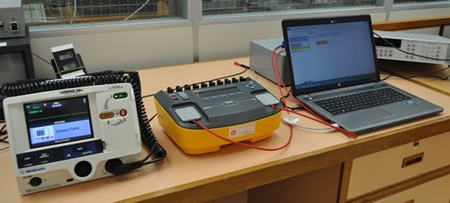 Defibrillator Analyzers
Defibrillator Analyzers
Defibrillators are medical devices designed to resume the normal heart pulse of a patient by discharging energy pulses to a person who is suffering from an emergency cardiac attack. They are commonly used in hospitals and medical institutes. At SCL, the energy delivered by a defibrillator is measured using a high quality digital sampling system. The system includes a high voltage divider, a sampling voltmeter, an impedance analyzer, and a control computer. The sampled voltage waveform is digitally processed to derive the delivered energy.
SCL offers calibrations for defibrillator analyzers. The calibration service covers the calibration of the energy measurement functions of the analyzers from 150J to 360J.
Electro-cardio graph (ECG) simulators
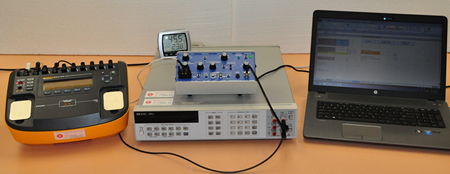 Electro-cardio graph (ECG) simulator
Electro-cardio graph (ECG) simulator
Electrocardiographs (ECG) are medical devices designed to measure the electrical signals associated with cardiac activities. They are used to diagnose heart diseases and arrhythmias, and are commonly used in hospitals, emergency facilities, and medical institutes. Routine performance check of ECGs could be performed by ECG simulators. To ensure the accuracy of ECGs, traceable calibration is essential. At SCL, the output signal from an ECG simulator is measured by a differential amplifier and a high-speed digital sampling system. SCL offers calibrations for ECG simulators with sinusoidal output waveform from 10 Hz to 200 Hz. The calibration range covers voltage level from 1 mV to 5 mV.
Distortion Meters
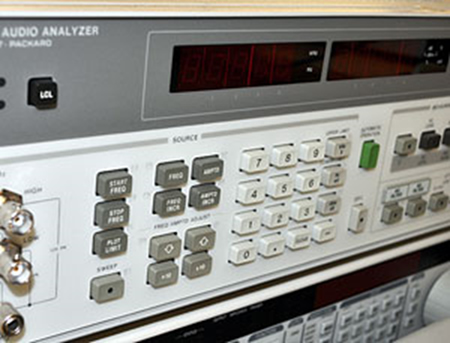 Distortion meters
Distortion meters
SCL has set up calibration facilities for distortion meters at frequency range from 40 Hz to 100 kHz. Calibration will be made by applying test signal with known distortion level to the meter under test. The test signal is about 1 V to 1.5 V. The distortion level is from -10 dB to -70 dB. ..
Harmonic Analyzers and Harmonic Sources
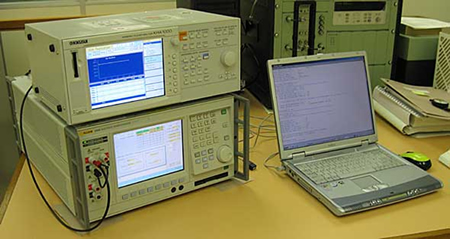 Voltage Harmonics Measurement
Voltage Harmonics Measurement
The Laboratory offers calibration for harmonic analyzers and harmonic sources.
The calibration service for harmonic analyzers covers the calibration of the voltage and current harmonics measurement functions of the analyzers from 2nd to 45th harmonic order. Calibration will cover harmonic voltage from 10 V to 12 V and 20 V to 24 V, harmonic current from 3 mA to 6 A.
The calibration service for harmonic sources includes the measurement of the generated voltage and current harmonics from 2nd to 100th harmonic order. Calibration will cover harmonic voltage from 10 V to 12 V and 20 V to 24 V, harmonic current from 10 mA to 6 A.
Programmable Filters
 Programmable Filters
Programmable Filters
The Laboratory offers calibration for programmable filters.
Attenuation of the filters at passband and stopband will be measured. The test voltage will be 3.2 V and calibration will cover frequency range from 20 Hz to 25 kHz.
Strain Gauge Meter
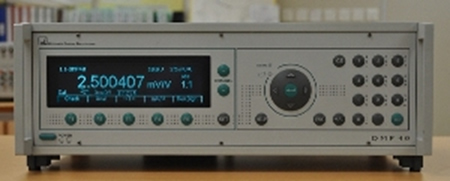 Strain Gauge Meter
Strain Gauge Meter
Strain gauge transducers together with strain gauge meters are used to measure the strain of an object.
During measurement, an excitation signal (usually at a frequency of 225 Hz) produced by the strain gauge meter is fed to the strain gauge transducer. The transducer generates an output voltage proportional to the excitation signal and the measured strain.
Strain gauge meters are calibrated by simulating the transducers using two accurate and stable Inductive Voltage Dividers (IVDs). The excitation output of the strain gauge meter is connected to the two IVDs and the output from the two IVDs is fed to the transducer input port of the meter. The reading of the meter and the settings of the IVDs are compared.
The strain gauge meter is normally calibrated from 0.25 mV/V to 10 mV/V.